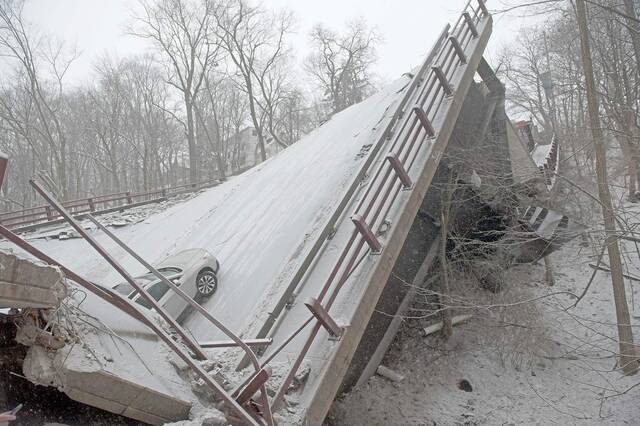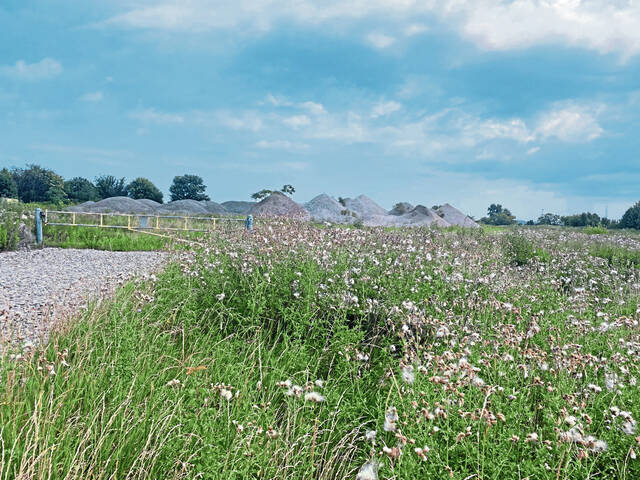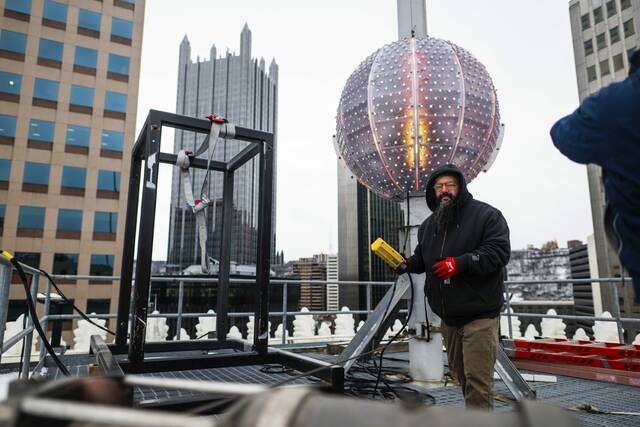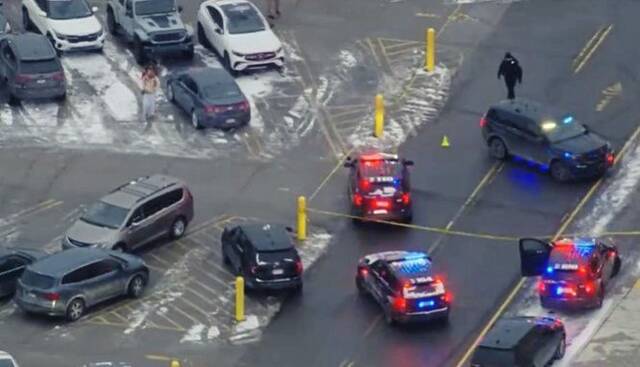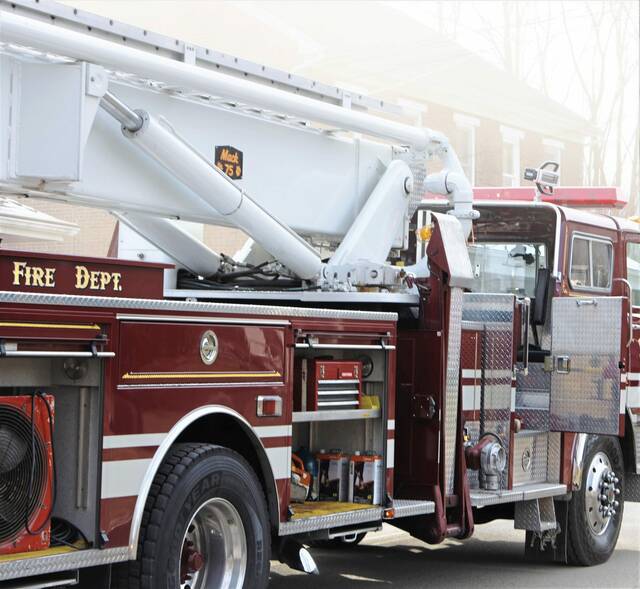Top Stories
‘It’s a resource problem’: 1 in 8 bridges in Pa. rated in ‘poor’ condition, records show

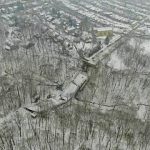
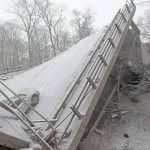
A bridge that collapsed in Pittsburgh’s Frick Park is one of hundreds of bridges rated in similar “poor” condition throughout the region and one of thousands across Pennsylvania.
Ten people were injured Friday morning when Fern Hollow Bridge, which carries Forbes Avenue over Fern Hollow Creek, collapsed, sending a Port Authority bus and other vehicles into a ravine below.
The bridge, a major artery between Squirrel Hill and Regent Square, Wilkinsburg, Swissvale and the Parkway East, was last inspected in September. PennDOT listed the bridge’s condition as “poor,” meaning “deterioration of primary structural elements has advanced.”
In all, Allegheny County has about 175 bridges — state owned and locally owned — rated in “poor” condition, according to PennDOT records. In Westmoreland County, that number is closer to 140.
The cause of the Frick Park bridge collapse is under investigation, city officials said. Investigators from the National Transportation Safety Board arrived in Pittsburgh on Friday evening. They said their investigation could take 12 to 18 months and maybe longer.
Built in 1970, the 447-foot-long bridge was restricted to vehicles weighing up to 26 tons. It is owned and maintained by the city of Pittsburgh.
City officials did not immediately respond to requests for additional information about the bridge’s condition before the collapse.
It is one of 80 locally owned bridges in Allegheny County in poor condition, according to PennDOT data. That represents about 20% of the county’s 397 locally owned bridges.
Across the state, about 26% of Pennsylvania’s 6,647 locally owned bridges are in poor condition, according to PennDOT.
PennDOT data shows that locally owned bridges — like the one that collapsed in Frick Park — tend to be in worse shape than the ones owned and maintained by the state.
Records show 8% of Allegheny County’s 1,186 state-owned bridges are in poor condition and 9.6% of Pennsylvania’s 25,437 state-owned bridges are in poor condition.
Altogether, combining state- and locally owned bridges, PennDOT figures show that nearly 4,200 of Pennsylvania’s roughly 32,000 spans are rated in poor condition — about 1 in every 8 bridges.
A PennDOT spokesperson declined to provide additional details about the collapsed bridge or the condition of bridges in Pennsylvania in general.
After reviewing reports about Fern Hollow Bridge, Kent Harries, an infrastructure expert who is an engineering professor at the University of Pittsburgh, said there was nothing “that flags it as being any worse than several other bridges with a similar rating.”
At just over a half-century, the bridge is not particularly old compared with other bridges in Pennsylvania, he added.
The bridge serves as a reminder that infrastructure needs to be better funded, Harries said.
“Ultimately, it’s a resource problem. You have an aging infrastructure deteriorating, as we’ve seen,” he said.
The cost of addressing structural issues of Pittsburgh’s bridges alone would be upward of $458 million, the New York Times reported, citing an analysis of 2020 National Bridge Inventory data by Daniel Armanios, a professor of major program management at the University of Oxford, and Cari Gandy, a doctoral student at Carnegie Mellon.
The $1 trillion infrastructure bill that President Biden spearheaded is “only a small percentage of what’s needed nationwide” but a sign of progress in investing in infrastructure like bridges, Harries said. Even with funding, he said, it would be a time-consuming effort to upgrade all of the state’s aging infrastructure.
Jonathan Shimko, past president of the Pittsburgh branch of the American Society of Civil Engineers, said about $1.6 billion of the infrastructure bill is expected to be allocated for Pennsylvania’s bridges.
“This is really just magnifying the point that we have ignored our infrastructure for too long, and it is time to make the investments to improve it,” he said. “Every day we wait, things aren’t getting any younger. We can all agree this isn’t a partisan issue, because public safety and welfare shouldn’t be a political football.”
The bridge collapse also may be an opportunity to reevaluate the way bridge inspections are performed, Shimko said. He suggested requiring a professional engineer to oversee all inspections, something that is not currently part of the process, he said.
“We will use this as a learning opportunity to improve the way we do things in the future,” he said.
Still, Shimko said, people can rest assured that, under the current system, bridges are generally safe. He said this collapse isn’t an indication that more bridges ranked in poor condition are prone to the same fate.
Despite the problems that still need attention, Pennsylvania is going “in the right direction” when it comes to repairing deteriorating bridges, Harries said.
Fifteen years ago, about 1 in 4 state bridges was considered structurally deficient.
The collapsed bridge Friday raised concerns among local residents who travel the roadway regularly. PennDOT records indicate about 14,500 vehicles use the bridge daily.
Jim Busis, a Squirrel Hill resident and publisher of the Pittsburgh Jewish Chronicle, said the state of the bridge and lack of investment in repairing it are “sad, but not that surprising.”
“We have so many bridges, and so many of them are in poor condition,” Busis said. “Thank God nobody was seriously hurt. … I’m sure there will be a lot of questions about how it is that this bridge suddenly collapsed.”
In addition to investigating Friday’s collapse, Busis said the next “most important question is, what about the other several hundred bridges in Pittsburgh — and which of them are in danger of collapsing?”
“Do we know? Is anyone doing anything about them?” Busis said. “Should any of them be preemptively closed?”
Harries said there’s no reason to believe this major collapse is a sign other structures are dangerous. Bridges, even those rated as being in poor condition, are generally safe, he said. PennDOT and other officials tend to err on the side of caution and close bridges and roadways that seem dangerous or unstable, he said, but it’s impossible to bring the risk factor to zero.
“All in all, we’re doing a good job of managing a deteriorating situation,” he said. “There will be more bridge collapses. Certainly, finding more resources will help to mitigate that in the future.”
City Controller Michael Lamb said the bridge collapse “is a reminder that investments in infrastructure are investments in public safety.”
Allegheny County is home to more structurally deficient bridges than any other county in the country, he said.
“If we do not act,” Lamb said, “events like this will, unfortunately, continue to happen.”
The bridge collapse occurred just hours before Biden visited the city to discuss infrastructure. Biden visited the site when he arrived in Pittsburgh.
Regarding Pittsburgh’s poorly rated bridges, Biden said, “We are going to fix them all.”
About the Writers
Julia Felton is a TribLive reporter covering Pittsburgh City Hall and other news in and around Pittsburgh. A La Roche University graduate, she joined the Trib in 2020. She can be reached at jfelton@triblive.com.




